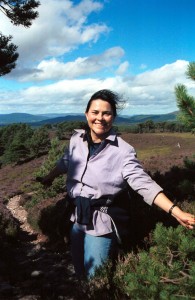Yesterday I finished reading the fifth book in Diana Gabaldon’s Outlander series—The Fiery Cross—for the second time.
This is the one that begins in 1770, with Clare, Jamie, et al., in North Carolina—embroiled in the War of Regulation, early conflicts preceding the Revolutionary War. As with all the Gabaldon novels, it is an intriguing blend of romance, adventure, time travel, and history, with touches of the supernatural and—for want of a better word—magic. At 979 printed pages, it’s also typical Gabaldon length!
Apart from Virginia Is For Mysteries Volume II authors, Gabaldon is the only fiction writer I’ve read in months. A fellow writer at Nimrod Hall last summer, Frances Birch, was reading one of the novels and recommended it. I love series, and so when I returned home, I ordered the Outlander series on Kindle.
First I read all eight of what Gabaldon calls “The Big, Enormous Books that have no discernible genre (or all of them).” Then I started over, this time including what she calls “The Shorter, Less Indescribable Novels that are more or less historical mysteries (though dealing also with battles, eels, and mildly deviant sexual practices),” as well as “The Bulges—These being short(er) pieces that fit somewhere inside the story lines of the novels. . . These deal frequently—but not exclusively—with secondary characters, are prequels or sequels, and/or fill some lacuna left in the original story lines.” These quotes, and the reading order I followed, are on Gabaldon’s website under Chronology of the Outlander Series.
Why spend so much precious reading time on one author—let alone rereading such tomes? I reread very few authors—the exceptions being Jane Austen, Dorothy L. Sayers, and Edgar Allan Poe. But Gabaldon has mastered the combination that hooks me: intriguing, convoluted plot twists; fresh, vivid language; fascinating characters; realistic details; and emotional appeal. I could go on, but you get the idea.
Then I picked up The Outlandish Companion and became fascinated by the woman herself.
Gabaldon holds a B.S. in zoology, an M.S. in marine biology, and a Ph.D. in ecology—all of which, I believe, add richness to the amazing amount of natural history that permeates her writing. Her varied career included “butchering” seabirds, “torturing boxfish,” and writing Fortran programs to analyze the contents of bird gizzards. But the deep-seated urge to write fiction never died. It reminds me of myself, who tried my hand at poetry, humorous plays, etc. in high school but never wrote fiction again till after more than twenty-five years as a psychologist and academic!
As a writer, I am amazed that Gabaldon can write such intricate plots. She has a cast of thousands—figuratively speaking. In actuality, it’s merely scores! But she manages to make characters individuals. They often disappear for a bit, but come back vividly—and still very much as they were—often as things go from bad to worse for the main character(s). She is able to cue readers to remember the character and/or relevant event without being boringly repetitious. Her historical research seems impeccable. And she has absolutely mastered flashbacks!
I admire Gabaldon for breaking all the rules. She didn’t “learn” to write fiction; she just did it. She paid no attention to genre constraints, page counts, or how she “ought to” go about it. She doesn’t start at the beginning and she doesn’t know the end when she starts. Perhaps that’s why her writing seems so fresh.
My advice to readers and writers
Get involved with Diana Gabaldon! Read her fiction, go behind the scenes in the Outlandish Companion volumes, and visit her online.

You might have heard that Starz made a television series of Outlander. Season two begins tomorrow, April 9th, with “Through a Glass, Darkly.” It’s inspired by the events in the second book, A Dragonfly in Amber. There are lots of events going on to celebrate the books and the new series. For a short time, you can watch all the first season’s episodes for free. But I still recommend reading the books.




